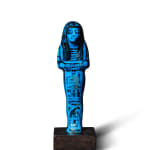Egyptian
An Egyptian bright blue faience shabti for the King's Wife Nesmut, New Kingdom, Ramesside, 19th Dynasty, circa 1295 - 1186 BC
Faience
Height: 14.5 cm
The statuette is in the form of a mummy, wrapped in a shroud and standing upright with both feet together. The hands are crossed on the chest and hold a...
The statuette is in the form of a mummy, wrapped in a shroud and standing upright with both feet together. The hands are crossed on the chest and hold a pair of A-shaped hoes, with a seed bag over the shoulders. The figure wears a tripartite black painted wig with a broad collar. The inscriptions which cover the lower part of the statuette usually indicate the name of the shabti's ancient owner and also contain an excerpt from Chapter 6 of the Egyptian Book of the Dead. The text on this example is in the form of a vertical column down the front of the legs, giving the deceased's name as the King's Wife Nesmut.
Provenance
Franziska Gassner (1907-2005) Collection, Ingelheim am Rhein, Germany, collected in the 1950s - 1970sLiterature
Shabtis were included in burials to act as workers for the deceased should they be called upon to perform agricultural work in the afterlife.There is a reference to the King's Wife Nesmut in W. Grajetzki, Ancient Egyptian Queens, London, 2005, p. 77: the tomb of the King's Wife Nesmut is mentioned in papyrus Mayer A as one that has been robbed in antiquity. The papyrus, known as the 'Tomb Robbery Papyrus', dates to the end of 20th Dynasty and is a legal document containing a portion of evidence from the trial of some tomb robbers at Thebes (National Museums Liverpool, World Museum acc. no. M11162). Nesmut is otherwise unknown so this is a rare and important shabti.



